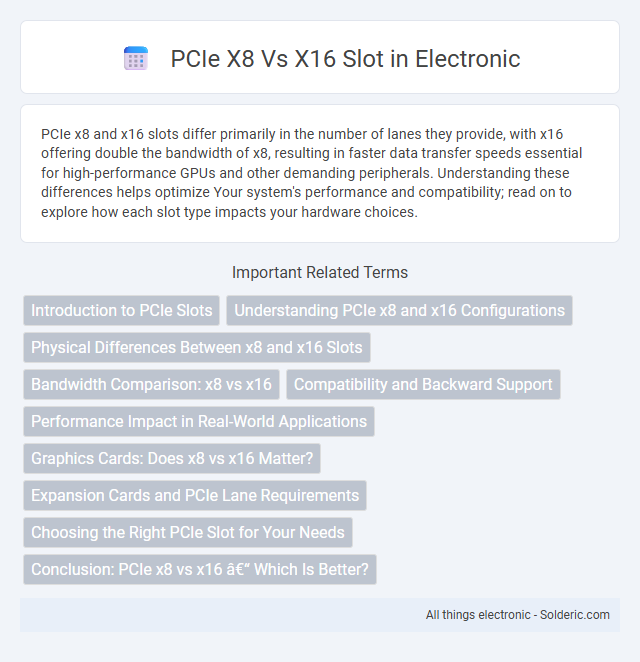PCIe x8 and x16 slots differ primarily in the number of lanes they provide, with x16 offering double the bandwidth of x8, resulting in faster data transfer speeds essential for high-performance GPUs and other demanding peripherals. Understanding these differences helps optimize Your system's performance and compatibility; read on to explore how each slot type impacts your hardware choices.
Comparison Table
| Feature | PCIe x8 Slot | PCIe x16 Slot |
|---|---|---|
| Lanes | 8 lanes | 16 lanes |
| Bandwidth (Gen 3) | 7.88 GB/s (full duplex) | 15.75 GB/s (full duplex) |
| Bandwidth (Gen 4) | 15.75 GB/s | 31.5 GB/s |
| Common Use | Network cards, mid-range GPUs, storage controllers | High-end GPUs, advanced storage, accelerator cards |
| Physical Size | Shorter slot than x16 | Longer slot with up to 16 lanes |
| Compatibility | Supports x8 and lower cards | Supports x16 and smaller cards |
| Performance Impact | Limited maximum throughput due to fewer lanes | Maximum throughput and performance potential |
Introduction to PCIe Slots
PCIe slots are high-speed interface connectors on a motherboard that connect expansion cards like GPUs, SSDs, and network cards. The main difference between PCIe x8 and x16 slots lies in their lane count, with x16 offering 16 data lanes and x8 offering 8, affecting data transfer speeds and bandwidth. Your choice between PCIe x8 and x16 impacts the performance of devices that rely on maximum throughput, such as graphic cards and NVMe SSDs.
Understanding PCIe x8 and x16 Configurations
PCIe x8 and x16 slots differ primarily in lane count, with x8 having 8 lanes and x16 having 16 lanes, directly impacting bandwidth and data transfer speeds. PCIe x16 slots provide double the bandwidth of x8 slots, making them ideal for high-performance graphics cards and data-intensive applications. Compatibility varies; many motherboards and GPUs support x8 operation in x16 slots, allowing flexible configuration without significant performance loss in certain use cases.
Physical Differences Between x8 and x16 Slots
PCIe x8 and x16 slots differ physically primarily in size, with the x16 slot being twice as long to accommodate more lanes for data transfer. The x8 slot has 8 lanes, each consisting of two pairs of wires for sending and receiving data, while the x16 slot has 16 lanes, allowing double the bandwidth. Your motherboard's design dictates the available slot type, which directly impacts graphics card compatibility and performance potential.
Bandwidth Comparison: x8 vs x16
PCIe x16 slots offer double the bandwidth of PCIe x8 slots, with x16 providing up to 32 GB/s and x8 delivering up to 16 GB/s in PCIe 3.0 configuration. The increased lane count in x16 slots significantly improves data transfer rates, making them ideal for high-performance GPUs and storage devices requiring maximum throughput. For applications with moderate bandwidth needs, PCIe x8 slots provide sufficient performance at reduced complexity and cost.
Compatibility and Backward Support
PCIe x8 slots are fully compatible with x16 cards, allowing your high-performance GPUs or expansion cards to operate without limitations, although at potentially reduced bandwidth compared to an x16 slot. Both x8 and x16 slots maintain backward compatibility with previous PCIe generations, ensuring seamless support for older devices while boosting flexibility in system upgrades. Your motherboard's PCIe architecture typically supports cross-compatible configurations, optimizing device connectivity and enhancing overall performance.
Performance Impact in Real-World Applications
PCIe x16 slots offer double the lanes of x8 slots, delivering up to 32 GB/s bandwidth compared to 16 GB/s in PCIe 3.0, which directly affects data transfer speeds for GPUs and storage devices. In real-world applications like gaming or 3D rendering, the performance difference is generally minimal, with only a 1-3% improvement in frame rates or processing times. You will notice more significant impacts in data-intensive tasks requiring maximum GPU power or high-speed NVMe SSDs, where the extra lanes of x16 slots reduce bottlenecks and improve overall throughput.
Graphics Cards: Does x8 vs x16 Matter?
Graphics cards typically benefit from PCIe x16 slots due to the increased bandwidth that supports higher data transfer rates essential for gaming and professional applications. However, modern GPUs often perform similarly in PCIe x8 slots since PCIe 3.0 and 4.0 standards provide sufficient bandwidth to handle most graphics workloads without significant bottlenecks. Your choice between x8 and x16 slots should consider the specific GPU model and the PCIe generation to ensure optimal performance for your system.
Expansion Cards and PCIe Lane Requirements
PCIe x16 slots offer 16 lanes for data transfer, providing higher bandwidth essential for expansion cards like high-performance graphics cards and NVMe RAID controllers that demand extensive PCIe lane requirements. PCIe x8 slots, with only 8 lanes, suit expansion cards such as network adapters or storage controllers that require moderate bandwidth. Your choice between x8 and x16 slots should align with the expansion card's lane requirements to ensure optimal performance and compatibility.
Choosing the Right PCIe Slot for Your Needs
Choosing the right PCIe slot depends on your device's bandwidth requirements and your motherboard's layout. PCIe x16 slots offer double the lanes compared to x8 slots, providing higher data transfer rates essential for graphics cards and high-performance SSDs. You should match your hardware to the slot that maximizes performance without wasting available lanes, ensuring optimal system efficiency.
Conclusion: PCIe x8 vs x16 – Which Is Better?
PCIe x16 slots provide double the lane count of PCIe x8 slots, delivering significantly higher bandwidth up to 16 GB/s compared to 8 GB/s in PCIe 3.0, which makes them ideal for high-performance GPUs and bandwidth-intensive applications. PCIe x8 slots are often sufficient for many use cases, including mid-range GPUs and SSDs, offering a cost-effective solution with lower power consumption. Choosing between PCIe x8 and x16 depends on the specific hardware requirements and whether the workload benefits from the increased data transfer speed and capacity of the x16 interface.
PCIe x8 vs x16 slot Infographic

 solderic.com
solderic.com